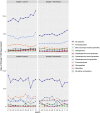Assessing feasibility of establishing antimicrobial stewardship programmes in two provincial-level hospitals in Vietnam: an implementation research study
- PMID: 34598989
- PMCID: PMC8488745
- DOI: 10.1136/bmjopen-2021-053343
Assessing feasibility of establishing antimicrobial stewardship programmes in two provincial-level hospitals in Vietnam: an implementation research study
Abstract
Objectives: To investigate the feasibility of establishing hospital-based antimicrobial stewardship (AMS) programmes comprising action-planning, educational interventions and data feedback in two provincial-level hospitals in Viet Nam.
Design and setting: This was an implementation research using participatory action process and existing resources from the Duke Antimicrobial Stewardship Outreach Network with local adjustments. A national stakeholder meeting and Strengths-Weaknesses-Opportunities-Threats (SWOT) analysis were conducted to identify gaps and potential interventions.
Participants: Hospital AMS staff implemented activities throughout the study phases. Routinely collected patient data were analysed to support planning, implementation and evaluation.
Interventions: Hospitals were considered as a complex adaptive system and leveraged their unique characteristics and interconnections to develop 1-year plans containing core interventions (data use, educational training, prospective audit with feedback (PAF) and evaluations).
Outcome measures: We assessed feasibility using outputs from stakeholder meeting, SWOT analysis, baseline data, planning process and implementation.
Results: The stakeholder meeting identified three gaps for AMS at national level: supportive policies, AMS training and core competencies and collaboration. At the hospitals, AMS programmes took 1 year for planning due to lack of hospital-specific procedures and relevant staff competencies. Baseline data (January-December 2019) showed variations in antibiotic consumption: 951 days of therapy (DOT) per 1000 days present in the control and 496 in the intervention wards in hospital 1, and 737 and 714 in hospital 2, respectively. During 1-year implementation, clinical pharmacists audited 1890 antibiotic prescriptions in hospital 1 (June 2020-May 2021) and 1628 in hospital 2 (July 2020-July 2021), and will continue PAF in their daily work.
Conclusion: Our data confirmed the need to contextualise AMS programmes in low-income and middle-income countries (LMICs) and demonstrated the usefulness of implementation research design in assessing programme feasibility. Developing staff competencies, using local data to stimulate actions and integrating programme activities in routine hospital work are key to success in LMICs.
Keywords: health & safety; health policy; health services administration & management; internal medicine; public health; quality in health care.
© Author(s) (or their employer(s)) 2021. Re-use permitted under CC BY. Published by BMJ.
Conflict of interest statement
Competing interests: None declared.
Figures



References
Publication types
MeSH terms
Grants and funding
LinkOut - more resources
Full Text Sources
